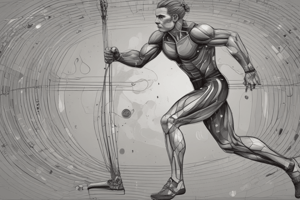Podcast
Questions and Answers
How does stronger contractions during exercise impact stroke volumes and cardiac output?
How does stronger contractions during exercise impact stroke volumes and cardiac output?
Increased stroke volumes, leading to improved cardiac output
What is one benefit of a stronger heart due to exercise?
What is one benefit of a stronger heart due to exercise?
Withstand higher levels of stress without experiencing fatigue quickly
How does consistent engagement in moderate-to-vigorous physical activity impact the risk of developing chronic diseases?
How does consistent engagement in moderate-to-vigorous physical activity impact the risk of developing chronic diseases?
Reduces the risk of developing various chronic diseases, including coronary artery disease and type 2 diabetes
How does exercise influence the respiratory system in terms of oxygen uptake?
How does exercise influence the respiratory system in terms of oxygen uptake?
How does exercise impact the strength of lung tissues?
How does exercise impact the strength of lung tissues?
How does regular aerobic exercise impact blood volume?
How does regular aerobic exercise impact blood volume?
What positive change occurs in the heart due to regular exercise?
What positive change occurs in the heart due to regular exercise?
Why is it beneficial for athletes to have an increased blood volume?
Why is it beneficial for athletes to have an increased blood volume?
How does the cardiovascular system respond to regular physical activities?
How does the cardiovascular system respond to regular physical activities?
What long-term impact can regular exercise have on the heart?
What long-term impact can regular exercise have on the heart?
Flashcards are hidden until you start studying
Study Notes
Sports Performance in Relation to Cardiovascular and Respiratory Systems
As athletes push their bodies to new limits, they also put stress on their cardiovascular and respiratory systems. These two body systems work together to provide oxygen and nutrients to muscles during physical activity while removing waste products like carbon dioxide. In this article, we will explore how these systems respond and adapt to exercise and sport participation, giving light to both the short-term and long-term impacts on overall health and athletic performance.
Effects of Exercise on Cardiovascular System
The cardiovascular system is responsible for supplying blood and oxygen throughout your entire body. When you engage in regular physical activities such as running, swimming, cycling, or playing team sports, it can lead to several positive changes within the heart and circulatory system. Here are some key ways that exercise affects the cardiovascular system:
-
Increased Blood Volume: Regular aerobic exercise helps boost plasma volume, which means more red blood cells are available to deliver oxygen to working muscles. This increase in circulation allows for better oxygen delivery even when under high-stress conditions like intense training sessions.
-
Improved Heart Function: Over time, regular exercise can strengthen heart muscle tissue, making it easier for the organ to pump blood efficiently. Stronger contractions mean increased stroke volumes, leading to improved cardiac output. Additionally, a stronger heart can withstand higher levels of stress without experiencing fatigue quickly.
-
Lowered Risk of Disease: Consistent engagement in moderate-to-vigorous physical activity has been shown to reduce the risk of developing various chronic diseases, including coronary artery disease and type 2 diabetes. A healthy cardiovascular system not only improves athletic performance but also contributes significantly to longevity.
Effects of Exercise on Respiratory System
While often overlooked by athletes who focus primarily on strength training or endurance events, the respiratory system plays a crucial role in supporting peak performance across all types of sports. It's responsible for moving oxygen from the air into our lungs and into our bloodstream. Here's how exercising influences the respiratory system:
-
Enhanced Oxygen Uptake: During exercise, especially if performed regularly, our breathing increases rapidly due to the need for more oxygen. Research suggests that over time, this leads to improvements in lung function—particularly in terms of ventilation efficiency and the ability to extract more oxygen from each breath. These enhancements result in higher VO₂ max values, meaning the individual can perform longer and harder before reaching exhaustion.
-
Strengthened Lung Tissue: Just as muscles grow larger and stronger through resistance training, the diaphragm and intercostal muscles involved in breathing can become stronger too. As a result, individuals may experience less discomfort at maximal exertion and may have a broader range of motion when performing tasks that require heavy breathing.
-
Reduced Susceptibility to Upper Respiratory Illnesses: Physical fitness, particularly endurance and cardiorespiratory fitness, can help protect against upper respiratory tract infections (URTIs) like colds or flu. Frequent exercises stimulate immune responses, making people more resistant to sickness.
Respiratory System Adaptations in Sports
Several unique respiratory adaptations occur among athletes participating in specific sports. For instance, swimmers and divers must hold their breath while immersed in water, relying entirely upon pre-breathing strategies. Moreover, those competing in extreme altitude events, such as mountaineering or cross-country skiing races, develop physiological adjustments to cope with reduced oxygen availability. Some notable examples include:
-
Hyperventilation Training: Swimming involves sustained periods where an athlete holds their breath underwater. To ensure adequate oxygen supply during diving maneuvers, swimmers sometimes train themselves to breathe out more completely just prior to submerging.
-
Training at High Altitude: Athletes preparing for events at elevated locations often live or train in hypoxic environments, where low oxygen levels encourage adaptation mechanisms such as increased production of red blood cells (erythropoiesis) and enhanced capillarization – both contributing factors to improved oxygen transport capacity.
-
Altitude Training Masks: To simulate high-altitude conditions, athletes wear masks that restrict ambient airflow, thereby reducing the amount of oxygen received during normal exhalation. Although controversial, this method aims to trigger similar acclimatization processes observed above sea level.
Cardiovascular System Adaptations in Sports
Cardiovascular adaptations typically involve structural, functional, and metabolic changes that optimize blood flow and oxygen delivery to working muscles. While many of these modifications overlap between different forms of exercise and sport, there are distinct variations based on training intensity and duration:
-
Warm-Up Activities: Before engaging in strenuous activities, people often partake in warm-up routines consisting of lower impact exercises. This gradual transition raises heart rate gradually, increasing blood flow to preload the cardiovascular system; thus, minimizing potential risks associated with sudden spikes in demand.
-
Endurance Events: Distance runners or triathletes frequently exhibit enlargement of left ventricular chamber size (LVESD), resulting in greater contractility and efficient utilization of oxygen. They might also demonstrate higher maximum heart rates compared to sedentary counterparts. However, elite marathon runners tend to have smaller hearts relative to slower competitors - likely reflective of their superior conditioning.
-
High-Intensity Interval Training (HIIT): HIIT regimes feature repeated bouts of intense activity separated by brief recovery intervals. This form of training seems advantageous for enhancing peripheral oxygen extraction, hence improving cardiovascular fitness despite shorter total workout durations compared to continuous exercise.
Conclusion
Understanding the interactions between sports performances and the cardiovascular and respiratory systems is essential for coaches, trainers, and athletes alike. By recognizing and utilizing appropriate techniques tailored to individual needs, participants can maximize benefits while mitigating risks related to prolonged exposure or excessive strain on either system. Continued research in this area promises further insights into personalized approaches promoting optimal health outcomes alongside competitive advantages.
Studying That Suits You
Use AI to generate personalized quizzes and flashcards to suit your learning preferences.




